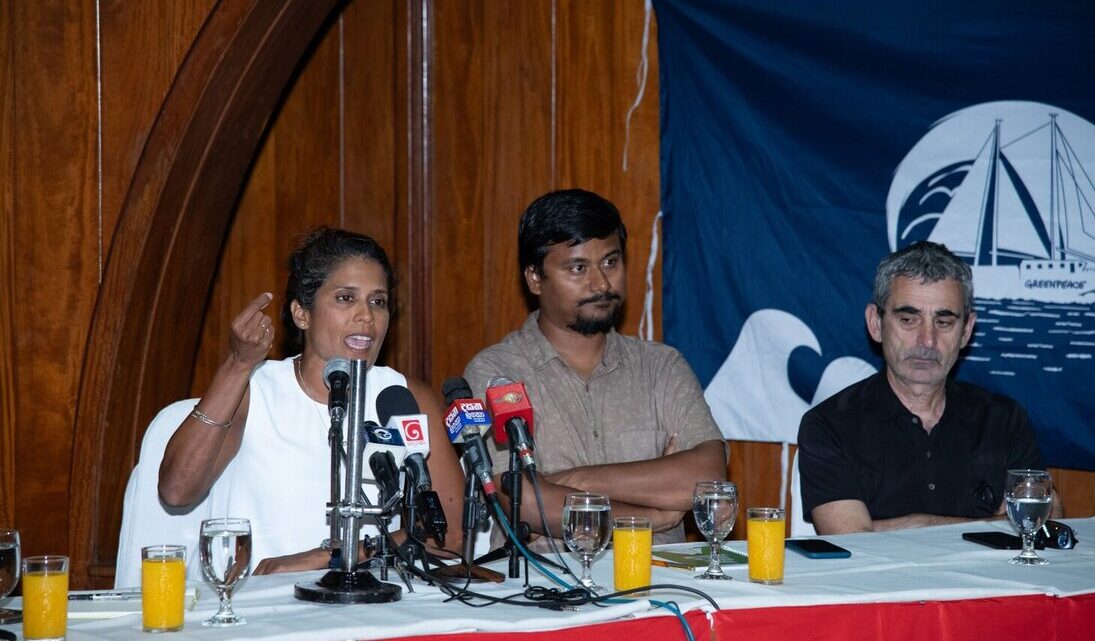
A first! Oceanswell and Greenpeace South Asia conduct cetacean surveys in the high seas of the Indian Ocean
Greenpeace South Asia and Sri Lankan marine conservation organisation Oceanswell have just returned to Colombo following the successful completion of cetacean visual and acoustic surveys in the high seas of the Indian Ocean aboard the Greenpeace flagship Rainbow Warrior. The scientific survey was conducted under the leadership of Dr. Asha de Vos, renowned cetacean researcher and founder of Oceanswell along with a young crew of Sri Lankans from Oceanswell.
The survey track covered a total of 2431 km over 10 days and was run in the northern part of the Ninety East Ridge located in international waters East of Sri Lanka and South of the Andaman and Nicobar islands. The goal was to explore and document the cetacean diversity of this remote part of the ocean through 10 days of visual and acoustic effort. The science team coupled daytime visual surveys with 24/7 acoustic surveys to build a picture of the cetacean life within the area. At least four species of dolphins – spinner, spotted, striped and bottlenose – were visually identified, pending further acoustic data analysis by Oceanswell.
“This is the first time a dedicated cetacean visual and acoustic survey has been conducted in this part of the Indian Ocean. Given that the Indian Ocean is still relatively understudied for cetaceans, the data we have gathered over these two weeks will contribute greatly to our knowledge base and help us start to paint a picture of the more remote parts of our Ocean home. The good news is that we spotted and heard several pods of at least four species of dolphins, and in most pods, we also saw calves, indicating that this area is important as a breeding/calving ground. Exploration of this nature is important to understand how to best focus our research and conservation efforts in the longer term. Access to the Rainbow Warrior enabled us to go beyond national waters into the high seas and complete this expedition successfully. We are excited to start analysing the data gathered during our time on the water to really shed light on what is happening in this corner of the Indian Ocean.” said Dr Asha de Vos
“The Indian Ocean is home to a staggering diversity of aquatic life and ecosystems. Considering this ocean is also warming at the fastest rate it is crucial to understand the nature of biodiversity that lives here. One of our efforts as Greenpeace South Asia is to ensure we work with communities and experts from the region to better understand the climate realities here. We are enthusiastic that the data that has been collected in this survey will help us understand the marine biodiversity here a lot better.” says Avinash Chanchal Kumar, Campaign Manager at Greenpeace South Asia.
Since 2019, Greenpeace has undertaken several ambitious cetacean surveys across diverse oceanic regions globally, covering 63,950 kilometers in acoustic survey effort. The surveys have resulted in the acoustic detection of 1181 groups. Among these remarkable findings are 388 groups of sperm whales, 31 groups of beaked whales, and 713 groups of dolphins, underscoring the vibrancy and diversity of marine life within the surveyed areas.
The UN Global Ocean Treaty adopted in 2023 would allow the creation of large-scale protected areas for the oceans. Ocean Sanctuaries designed to maximise the success of natural predatory species (like tuna, dolphins and sharks) also have the best chance of preserving blue carbon stocks.
Greenpeace South Asia is calling on all states in the region to ratify the Global Ocean Treaty to safeguard oceans biodiversity, support climate mitigation and the future of the next generations.
ENDS
Photo Caption-
Asha de Vos, Founder of Oceanswell and Marine biologist, Avinash Chanchal, Campaign Manager, Greenpeace South Asia, and Pep Barbal Captain of Rainbow Warrior